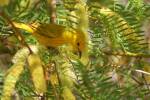Razor saw a good choice for pruning
Even though I do like to prune trees and shrubs, I don't do it professionally. I have never been all that nifty with tools. I can get by tightening a nut and bolt or do the odd handyman job, but I am not exactly nimble with hand tools. However, if I were to go into business professionally pruning trees, I would not have a huge pile of tools.
The primary pruning tool I do own is a handsaw. Over the years, I have had several different types of pruning saws -- those with curved blades and some straight. In the late 1980s, a saw was introduced to the industry that has revolutionized the way trees are cut. The Japanese tri-edge or razor saw quickly became the tool of choice for professionals.
The Japanese have been producing fine cutlery for centuries, but the creation of a saw with teeth that have three facets is remarkable.
At first, the saws were available only through arborist equipment dealers, and they were expensive. But as the blades were adopted by tree-care professionals for everyday use, the cost of the units dramatically dropped.
The beauty of the razor saw is how well it works. The saw primarily cuts on the pull stroke, and often it only takes one or two pulls to cut a small limb. And the quality of the cut is incredible. Professionals describe the cut as being so smooth that it appears that the surface has been sanded. Some report that they have abandoned chain saws for all pruning operations and only use the noisy beasts for removals. Now that certainly would make for a quieter job.
If you like to do your own pruning around the landscape, you might consider adding a razor saw to your weaponry. Loppers, those long-handled hook-billed cutters, can not compare to this saw for quality of cut. Use loppers to chop up limbs for the trash, but use a saw to delicately prune your fine fruit trees and your fair shade tree.
You can pick up a decent tri-edge razor saw at virtually any hardware store and nursery for as little as $20. Corona is a name brand that many will recognize for hand tools. The most common type available is a folding saw, where the blade snaps into a groove in the handle to safely store the sharp edge when not in use. If you decide to get a saw that does not fold, absolutely, purchase a scabbard for storing the saw. It is essential for safety.
For those of you that want the very best, consider shopping for Silky saws. This company imports only the very best and innovative Japanese saws. You will pay a bit more, but the quality and variety of tools is significant. Go online to www.silkystore.com to see the line of curved, straight and pole-mounted saws.
Remember that these little babies are very sharp. When they were first introduced, the dealers would tell the tree men to be careful because they were sure to cut themselves the very first day of use. The key was to keep the cut small. It is highly advisable to wear gloves when using a tri-edge saw, and to exercise great care when using it, as it can inflict a deep cut in seconds even with gloves.
The only other disadvantage to the razor saws is that it is difficult to sharpen the blades. Fortunately, the blades will stay sharp for quite a while with regular use. About the only ways you can ruin a razor saw is to cut roots in dirt, which really dulls a blade quickly, or bend it in a cut that binds the blade. In either case, toss the blade and buy a replacement to install in the handle. The cost will be slightly less than a complete replacement.
Now you, too, can make precision cuts or remove a whole tree in no time with a razor saw. Just be careful and have fun.
Dennis Swartzell is the marketing director for Mountain States Wholesale Nursery. As an ISA board-certified master arborist and a member of the American Society of Consulting Arborists, Swartzell has been helping Southern Nevadans with their gardening questions for over 20 years. If you have a question about a particular plant, or a general gardening issue, send them to Swartzell at treemender@cox.net.























